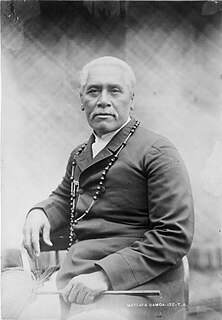 W
WGerman Samoa was a German protectorate from 1900 to 1914, consisting of the islands of Upolu, Savai'i, Apolima and Manono, now wholly within the independent state of Samoa, formerly Western Samoa. Samoa was the last German colonial acquisition in the Pacific basin, received following the Tripartite Convention signed at Washington on 2 December 1899 with ratifications exchanged on 16 February 1900. It was the only German colony in the Pacific, aside from the Kiautschou Bay concession in China, that was administered separately from German New Guinea.
 W
WThe Tripartite Convention of 1899 concluded the Second Samoan Civil War, resulting in the formal partition of the Samoan archipelago into a German colony and a United States territory.
 W
WMata'afa Iosefo was a Paramount Chief of Samoa who was one of the three rival candidates for the kingship of Samoa during colonialism. He was also referred to as Tupua Malietoa To'oa Mata'afa Iosefo.
 W
WThis article lists the colonial governors of Samoa, from the establishment of German Samoa in 1900 until the independence of the Western Samoa Trust Territory in 1962.
 W
WLauaki Namulau'ulu Mamoe was a renowned orator chief and the first leader of the Mau, a resistance movement in Samoa during colonialism. Mamoe was exiled to Saipan in 1909. He died in 1915 as he was taken back to Samoa.
 W
WThe Occupation of Samoa was the takeover – and subsequent administration – of the Pacific colony of German Samoa by New Zealand during World War I. It started in late August 1914 with landings by the Samoa Expeditionary Force from New Zealand. The landings were unopposed and the New Zealanders took possession of Samoa for the New Zealand Government on behalf of King George V. The Samoa Expeditionary Force remained in the country until 1915, while its commander, Colonel Robert Logan, continued to administer Samoa on behalf of the New Zealand Government until 1919. The takeover of Samoa was New Zealand's first military action in World War I.
 W
WThe Samoan Crisis was a standoff between the United States, the German Empire, and the British Empire from 1887 to 1889 over control of the Samoan Islands during the First Samoan Civil War. The incident involved three US Navy warships and three German warships, which kept each other at bay over several months in Apia Harbour, which was monitored by the British corvette HMS Calliope.
 W
WThe Second Samoan Civil War was a conflict that reached a head in 1898 when Germany, the United Kingdom, and the United States were locked in dispute over who should have control over the Samoan island chain, located in the South Pacific Ocean.
 W
WErich Bernhard Theodor Schultz-Ewerth was a German jurist, ethnologist and colonial administrator, who served as the last governor of German Samoa.
 W
WWilhelm Heinrich Solf was a German scholar, diplomat, jurist and statesman.
 W
WThe Tripartite Convention of 1899 concluded the Second Samoan Civil War, resulting in the formal partition of the Samoan archipelago into a German colony and a United States territory.
 W
WVailele is a village situated on the central north coast of Upolu island in Samoa.
 W
WWestern Samoa Mandate, then Western Samoa Trust Territory, was the official name of Western Samoa during its civil administration by New Zealand between 1920 and Samoan independence in 1962. Six years earlier, German Samoa was captured by the British shortly after the outbreak of World War I, but it would not be formally annexed by the British Empire until then.